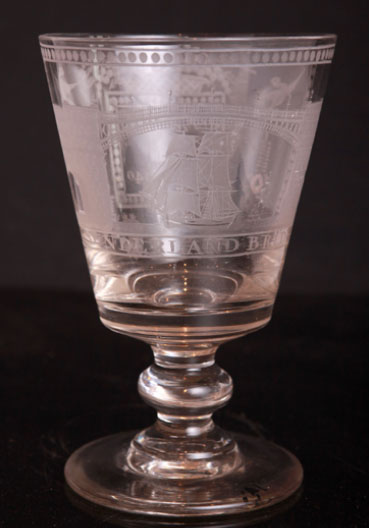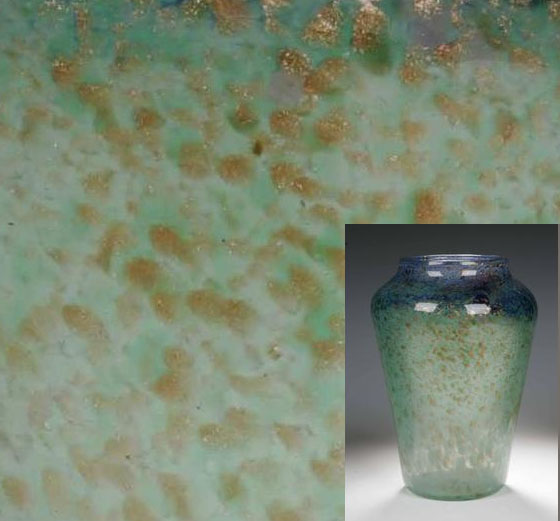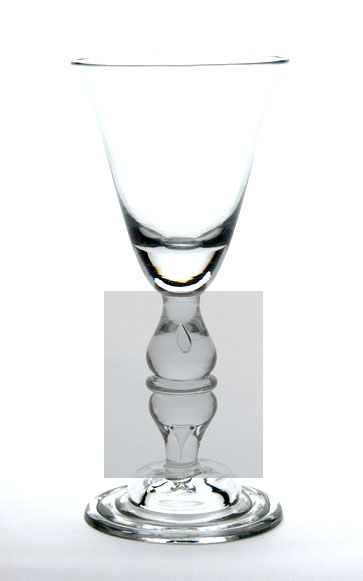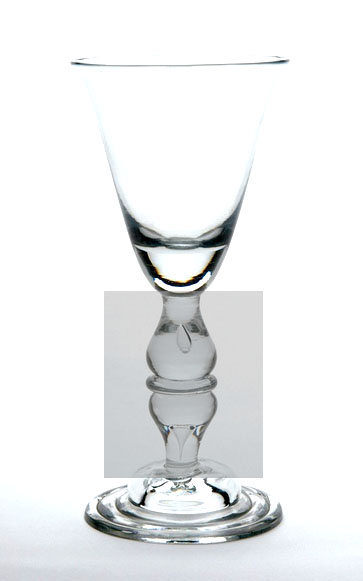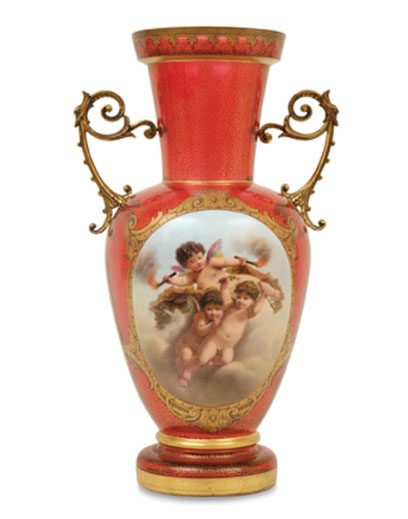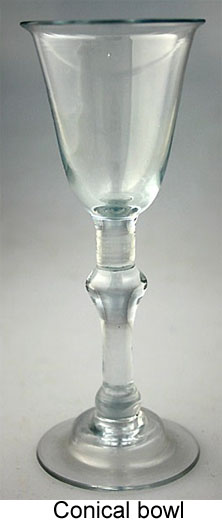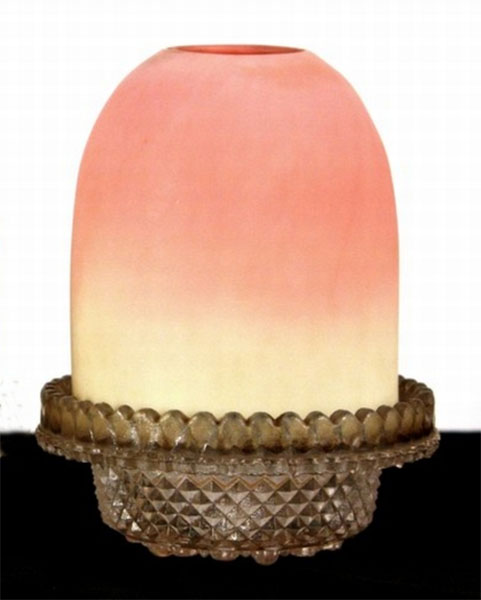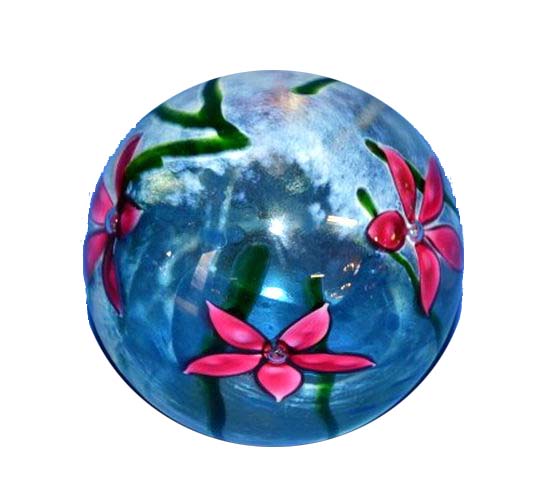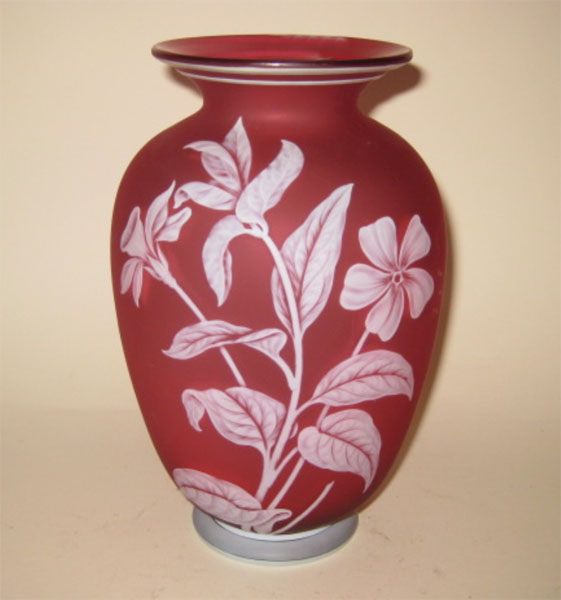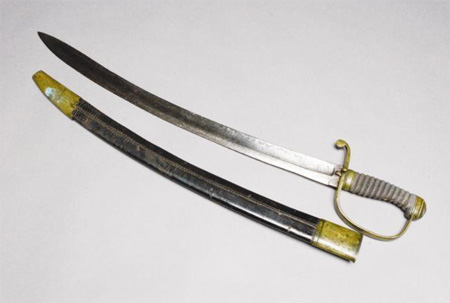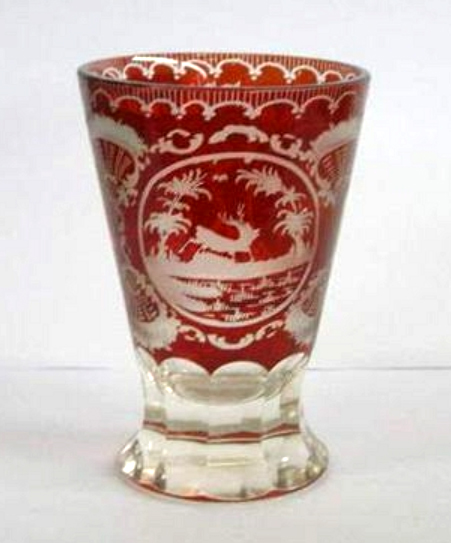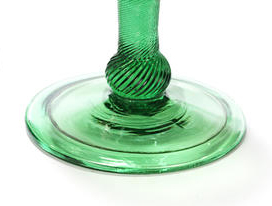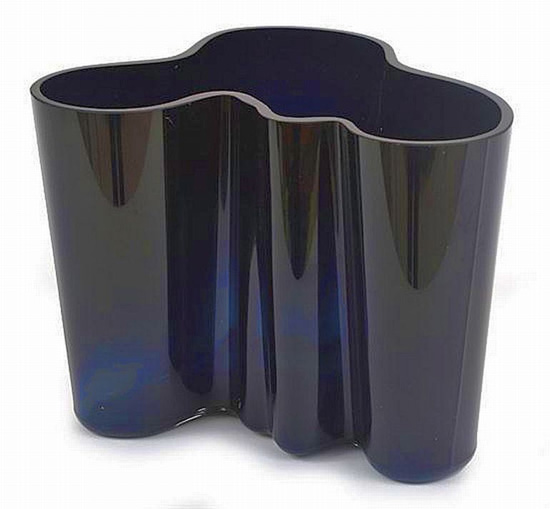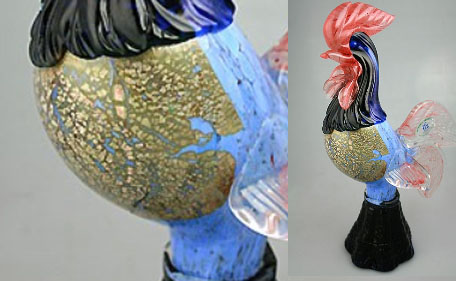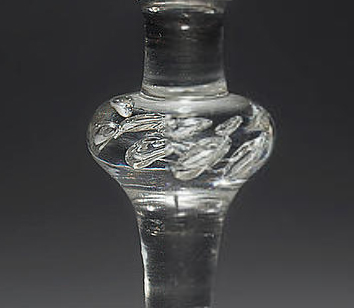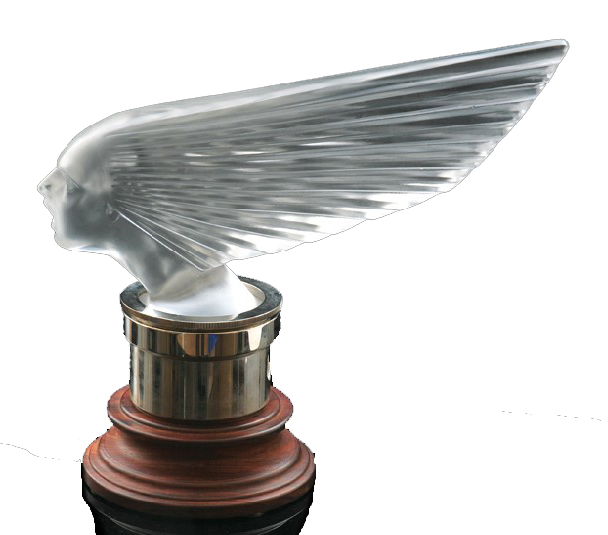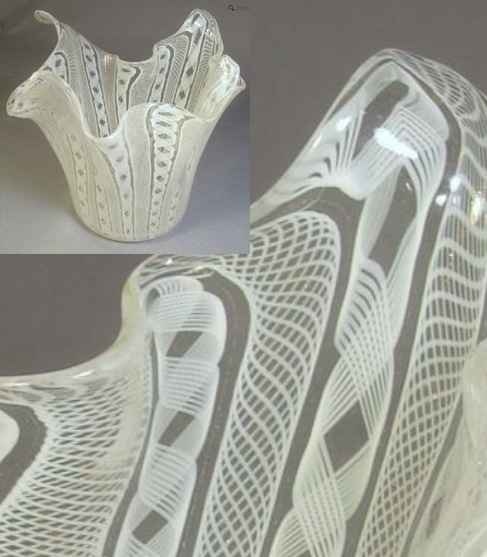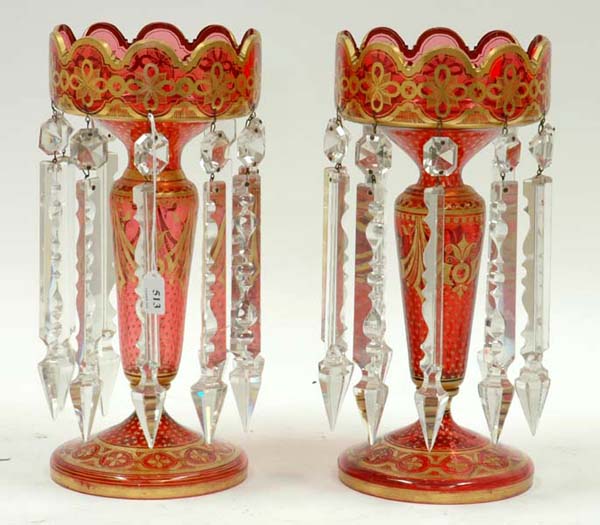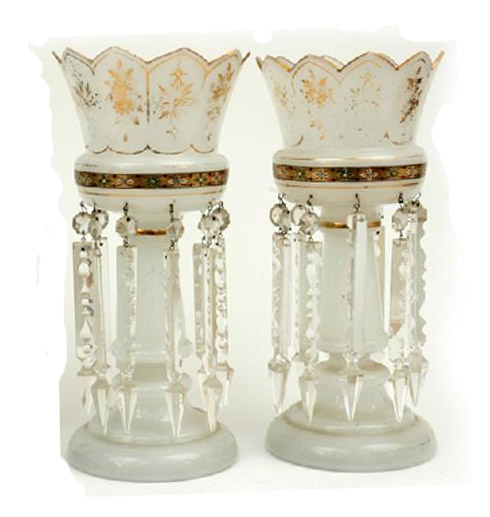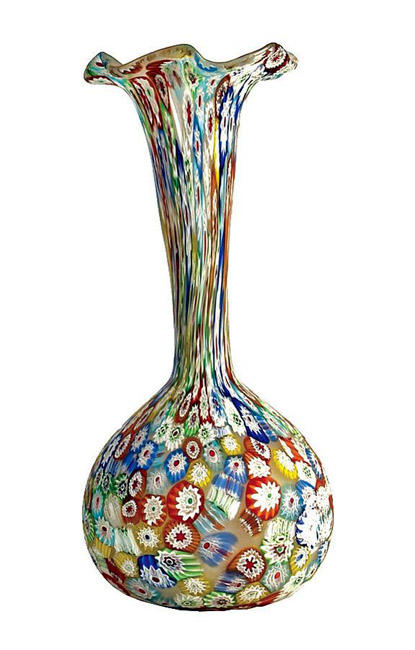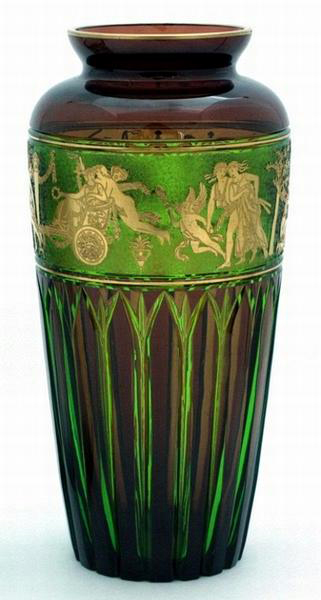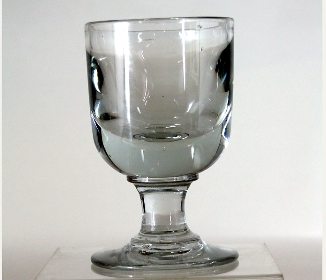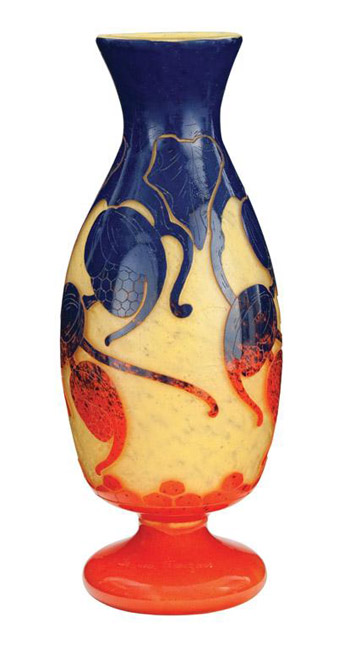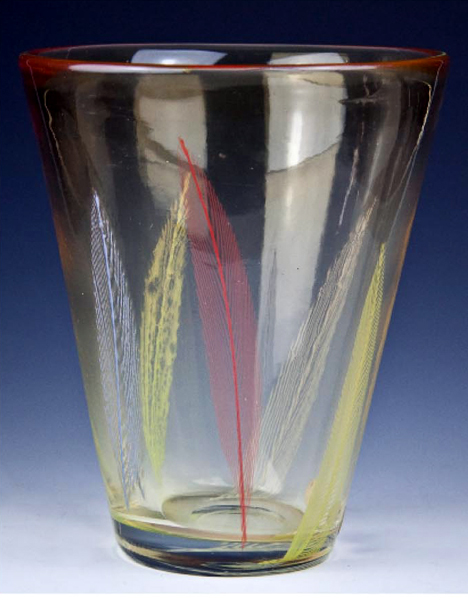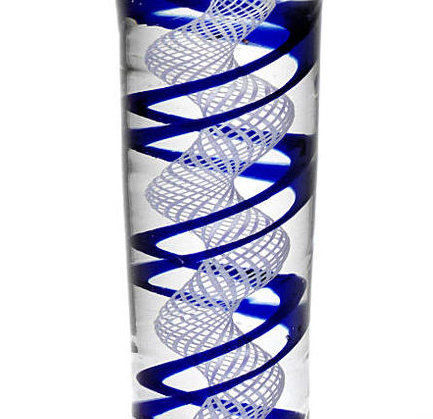Learn about antiques and collectables...
Click on a category below to show all the entries for that category.
Learn about and understand the items, manufacturers, designers and periods as well as the specialist terms used in describing antiques and collectables. Either click one of the letters below to list the items beginning with that letter, or click on a category on the left side of the screen to list the items under that category.
Acid Etched
Acid etching is often used on glass, metals, and stone to create decorative finishes or to prepare the surface for further treatment or coating. The process of acid etching involves applying an acidic solution, such as hydrochloric acid or nitric acid, to the surface of the material and allowing it to react with the surface. The acid etches away a thin layer of the material, creating a rough, uneven finish. Acid etching can be used to create a variety of different finishes, from a subtle matte finish to a more pronounced, textured finish.
Ale Glass
A type of Georgian glass used for drinking beer. The first versions in use in the early 17th century had a short stem and a small conical bowl, but by the later 17th century the shape had evolved, with the vessel being taller and having a longer stem and a rounded conical bowl. The bowl was sometimes decorated with engravings of barley ears or hops.
Alfredo Barbini
Alfredo Barbini (1912 - 2007) was a Italian master glassmaker. Born into a family who had been glassmakers for generations, he began in the trade in his early teens. After completing his apprenticeship and becoming a master glassblower, he worked for a number of the major Venetian glassworks, and in 1946 he became art director of Gino Cenedese & C. In 1950 he opened a glassworks in his own name which continued until his death in 2007.
Aurene Glass
Aurene glass is an iridescent coloured glass developed by Frederick Carder (1863-1963), while working at the Steuben Glassworks in the United States. Frederick Carder was an English glassmaker who emigrated to the United States in the early 1900s. He managed the Steuben Glass Works from 1903 to 1932, including the period after it was taken over by Corning Glass in 1918. Aurene is very similar to Tiffany's favrile glass, the colour obtained by combining metal and non metal glasses, onto which a solution of stannous chloride is sprayed, giving a velvety sheen to the brown, red, gold, blue and green colours.
Aventurine Glass
Aventurine glass is a type of glass where small flakes of gold, copper, or silver color form in the glass and provide a glitter or sparkle to the glass when seen in the light. The small flakes are created by adding copper, gold or silver to the molten glass during the glassmaking process.
Baluster (glass)
An architectural term for a column in a balustrade or staircase.
When used to describe glass, it can either refer to the shape of the stem of a wine glass, being slender above and pear shaped below, or the shape of the whole vessel, usually a vase. In fact the baluster shape is often described as being vase-like.
The description of a vase as being of baluster shape covers a wide variety of shapes that often bear no resemblance to the original architectural form.
Barovier & Toso
The Barovier family of Venetian glassmakers can trace their history back to the 13th century, and in 1884, Giovanni (1839 - 1908) together with nephews Benedetto (1857-1930), Giuseppe (1863-1942) and Benvenuto (1855-1932), all members of the Barovier family founded the Murano glassworks that became Artisti Barovier in 1890.
In 1919 Benvenuto's sons, Ercole (1889-1974) and Nicolo, and Giuseppe's son, Napoleone, joined the firm, creating the Vetreria Artistica Barovier, that was remarkable for its blown glass animals and murrine vases.
In 1919 Benvenuto's sons, Ercole (1889-1974) and Nicolo, and Giuseppe's son, Napoleone, joined the firm, creating the Vetreria Artistica Barovier, that became known its blown glass animals, murrine vases and, by 1929, the Primavera series of art deco style elegant vases in white glass with black handles.
Ercole Barovier took over as the artistic director of the company after World War I and the company was renamed Vetreria Artistica Barovier & C. he was able to innovate and create new chemical formulae, new colours and improved methods to manufacture glass.
The company merged with Ferro, Seguso and Toso in 1936 and in 1939 was renamed Barovier & Toso, remaining under the control of Ercole Barovier.
He remained the mainstay of firm until his death in 1972 when his son Angelo (1927 - 2008) took over. The company is still in operation under the control of Angelo.
Bohemian Glass
Bohemian glass, famous for its beauty and colour, has been in production since the 13th century, aided by the abundant natural resources found in the countryside, including potash which combined with chalk created a clear glass, wood to fire the kilns, as well as limestone and silica.
Bohemia became part of Czechoslovakia from 1918, and from 1993, part of the Czech Republic, although the word 'Bohemia' and variations on it continued in use in labeling glass.
By the mid 18th century Bohemian glass dominated world production and in the 19th century Bohemia became the centre for production of new types of coloured glass, including hyalith, lithyaylin, annagrun and annagelb.
'Mary Gregory' glass, in popular belief originated from a lady by that name either in America that painted scenes of children on ruby, blue or green glass using a white enamel paint mixed with ground glass, actually originated in Bohemia, and was a major export in the mid and latter quarter of the 19th century.
Mary Gregory glass, like many glass items from Bohemia does not carry a permanent manufacturers mark. If there was a paper label attached when it left the factory, the label has been worn or washed off during its many years of use.
As well as the unmarked items that are grouped under the general name of 'Bohemian glass', branded Bohemian based manufacturers and designers included well known names such Loetz and Moser and lesser known factories such as Kralik, Prachen and Rudolfova.
Bonbon Dish
A bonbon dish is a type of serving dish that is specifically designed to hold small, bite-sized candy or chocolates, which in the 19th century were also known as bonbons. They were often used for special occasions, like parties, weddings and holidays. They are also a common serving piece for after-dinner desserts, such as chocolates.
These dishes are often decorative and can be made from a variety of materials such as silver, glass, crystal, metal, or porcelain. Bonbon dishes come in many different shapes and sizes, but most are relatively small, and have a shallow bowl or dish shape.
Boss
A boss is small round or oval decorative device, used as ornament in Neo-classical style furniture, ceramics, sculpture and other decorative arts. They are usually applied to the surface in the form of stylized rosettes, but in the best pieces they are carved directly into the surface. Also known as paterae (or patera) or rosettes.
Bowl
With drinking glasses, the bowl is the hollow section of the glass that holds the liquid. Many glasses were mounted on a stem joined to a foot, others were cylindrical, of tumbler shape. The size and shape of the bowl was determined by the type of liquids they were meant to hold. Shapes used included bell shaped, conical (funnel), bucket shaped, trumpet, cup, ogee, funnel, cylindrical and rounded.
Burmese Glass
Burmese glass is an opaque art glass ranging in colour from pale yellow to a rich pink, due to the addition of gold and uranium oxides. The technique was patented by the Mount Washington Glass Company, USA, in 1885 and rapidly became one of the company's most popular lines.
The company granted a licence to Thomas Webb of Stourbridge, England to produce the glass, and such pieces often have an impressed mark on the base "Thos. Webb & Sons, Queen's Burmese Ware, Patented". The popularity of Burmese glass declined rapidly after 1900, but fine examples are now highly prized by collectors. Apart from table wares, small ornamental vases and dressing table accessories, it was a fashionable medium for lamps.
In 1969 the Fenton Art Glass Company of Williamstown West Virginia was able to replicate the process and has been producing Fenton Burmese glass for collectors, but ceased their production of collectable glass items in 2011.
Caithness Glass
Caithness Glass was founded in Wick in North East Scotland in 1961. In 1962, Paul Ysart, who had worked for Moncrieff glassworks (Monart) in Perth, Scotland, and whose father was a glassblower, joined as supervisor and the company started producing paperweights.
Its early tableware and decorative production was very similar to the Scandinavian glass popular at the time, being mould blown with thin rims, heavy bases and strong colours. Colours were inspired by the Scottish landscape, hence names such as ‘heather’.
Before 1968 few pieces were engraved. Some engraved pieces were produced after that year when Colin Terris, who had studied in Norway, joined the company. Most designs are abstract, but some ranges were inspired by natural or marine subjects, and lead to the realease of a new modern style range of paperweighs.
Tableware remained in production until the 1980s, when the factory began to concentrate further on paperweights, with a few decorative glass ranges still being made, primarily in mottled coloured glass and often with ‘painted’ enamel effects.
In 1988, Caithness bought the Wedgwood Glass factory at King’s Lynn and at one point had three factories. In 1996, the company, now with headquarters in Perth, was taken over by Royal Doulton and then by glqass tableware producers, Dartington Crystal in 2006. and is still in production today, primarily producing paperweights.
Cameo Glass
Cameo glass is produced by creating an object with several layers, usually incorporating an opaque glass on a coloured ground with a matt finish, and then removing the outer layer by hand or wheel carving or etching, to reveal the opaque glass underneath.
Revived in Britain in the late 19th century, the technique was known to the Romans, and is seen at its best in the famous Portland Vase, dated from 5 - 25 AD.
In Britain, the best and earliest cameo glass was engraved by hand, but towards the end of the 19th century when cameo glass increased in popularity, various mechanical processes were introduced. Cutting could be done on a wheel, but more often decoration was applied in acid-resistant materials and the surrounding area then removed by immersing in acid.
Cameo glass on a commercial basis, using acid-etching, was introduced by Thomas Webb in 1884 and from then until 1911, Webb Cameo glass, with its white floral or classical motifs on a coloured base, was exceedingly popular. These pieces were invariably stamped 'Webb's Gem Cameo' and many examples in the 1890s also bore the date of manufacture. Other companies producing cameo glass were Stevens & Williams of Stourbridge, and J. & J. Northwood.
From about 1884, Emile Galle began producing a type of cameo glass, in which the decoration was cut by a wheel into the various layers of coloured glass. Galle also adopted acid-etching in the 1890s to cope with the demand for cameo glass, mainly from the Near East and Mediterranean markets.
Cameo glass is sometimes confused with a white enamel-painted glass, of German or Bohemian origin, designed to compete against cameo glass
Carboy / Carboys
A carboy is a type of container, typically made of glass or plastic, that is used for holding and transporting large quantities of liquids, such as water, chemicals, or fermented beverages. The name "carboy" comes from the Persian word "qarabah," which means "large jug."
Carboys have been in use for centuries, dating back at least to medieval times. They were originally made of glass and were used to transport and store wine, beer, and other fermented beverages. They were also used for transporting and storing water and other liquids, particularly in the chemical industry. They may can be fitted with a variety of different closures, such as screw caps, snap-on lids, or pour spouts, depending on their intended use.
Comport
A comport is a type of decorative serving dish or bowl, typically used for desserts, fruits or other sweet treats. The comport is usually made from glass, silver or porcelain, which are materials known for their elegance and durability. They are often beautifully designed and decorated, and can be used as an elegant and decorative centerpiece for a table or dining room. They are also widely used as a decorative piece on the mantelpiece, sideboard, or other areas of the house.
Crackle Glass
A finishing process for glass that causes fine cracks to appear in the surface, so that it looks like cracked ice.. The glass piece while still hot is immersed in cold water causing the surface to crack. It is them reheated to seal the cracks.
The process is believed to have been invented in Venice in the 16th century.
Crackle glass is also known as craquelle glass, abd in the United States as ice glass.
Cranberry Glass
Cranberry glass is a type of glass that is characterized by its deep red color. It was first made in the 19th century and was particularly popular during the Victorian era. It was typically used to make decorative items such as vases and figurines. The red color was achieved by adding gold chloride or selenium to the glass mixture during the manufacturing process.
Crimped
A wavy effect on the the rims or lips of glass or silver vessels. Crimping was frequently used on brightly coloured Victorian glass.
Cut Glass
Cut glass is glassware decorated with facets, grooves and depressions of various sizes and shapes, made by cutting into the surface of the glass using a rotating abrasive wheel. The glass is ground so the surface consists of facets, which have a high degree of light refraction, so that the surface sparkles.
The techniques of glass cutting had been known since the 8th century BC, and the practice was revived in Bohemia and Germany in the early part of the 16th century and in England in the 18th century. Cutting became the most common method of decorating glass in the second half of the 18th century and the early 19th century.
Daum Nancy Glass
The "Verrerie de Nancy" glassworks in Nancy were purchased in 1878 by Jean Daum (1825–1885) and then taken over by his two sons, Auguste (1853-1909) and Antonin (1864-1930) in 1887. They firstly produced coffee and tea services in clear glass with gold rims.
In 1893, the Daum brothers began producing cameo glass, using acid-etching techniques to decorate their wares with bouquets of flowers, clusters of fruit and scenery. During the Universal Exhibition of 1900 Daum was awarded a ‘Grand Prix’ medal.
The award allowed them to move out of the shadow of fellow Nancy glass maker, Emile Galle. In 1904 Galle died, and after that Daum established their prominence in the Nancy glass industry. Though their work during that period closely parallels that of Galle, it is much more yellow and orange in colour.
In 1914 on the outbreak of World War I the plant was closed, and converted into a hospital. It reopened after the war under Paul Daum, son of Auguste, and produced designs in the Art Deco style.
In the 1930's the styles became much plainer and utilitarian, as demonstrated by the 90,000 piece order for the luxury liner "Le Normandie".
The company is still under the name Cristallerie Daum, operating since 1962 as a public company. They make all kinds of figurines in pate-de-verre and crystal glass, as well as their high quality tableware.
Glassware by this company is signed 'DAUM NANCY' with the Cross of Lorraine.
Decanters
The earliest decanters date from the late seventeenth century and were made from blown moulded glass.
They were used to serve wine at a time when there was a move towards less formal dining procedures and the reduced reliance on servants and waiters.
The 1745 Excise Tax caused manufacturers to make decanters lighter in weight. The tax benefited the industry in Ireland where it did not apply. When the tax was repealed in 1845, a heavier gauge was reverted to.
In the second half of the eighteenth century blue, green and amethyst coloured decanters were made.
Decanters often sat on silver bottle coasters with baize bases (some even on castors) and could be 'pushed' around the dining table without making scratches or requiring serving staff.
Degue
Degue was the mark used by the Cristalleries de Compiegne (Glassworks of Compiegne), set up in Compiegne, a town about 50 km north of Paris.
The business was established by David Guéron (1892 – 1950). to produce tableware and other functional glass, but after the 1925 Exposition des Arts Decoratifs in Paris the company began producing art glass.
In order to promote the "Degue" name the company also set up a showroom and glassworks in Paris.
The art glass range included vases, paper weights, bowls, lightshades, chandeliers, table lamps, shades.
The company was involved in litigation for six years with Société Anonyme des Verreries Schneider, who produced glass under the "Le Verre Francais" name, accused of copying their designs, and when the case was settled in 1932, both companies were financially exhausted
The company was further weakened by the general strikes in 1936 occasioned by the election of the Popular Front in May 1936, and it ceased production.
The business was officially closed in 1939 at the beginning of World War II.
Engraved Glass
The method of decorating glass by marking the surface with a sharp intrument such as a diamond, metal needle or rotating cutting wheel. As pressure is applied to the surface, best results for engraving are achieved if the glass is of sufficient thickness. In the 19th century etching was used to decorate some table glassware that was too fine to take an engraving tool.
Epergne
A table centrepiece, which may have a large central bowl or dish, and a series of smaller bowls suspended from a central stem or branches, with the smaller bowls used to display sweetmeats. Some of the grander examples were made in silver, but epergnes were also made in ceramic and glass.
Etched
Glass decorated with an etched design, which is achieved through marking out the pattern, protecting the area that is not be etched, and then immersing the object in acid to dissolve the surface of the unprotected area. With some glass objects, such as cameo glass, there may be several layers of different coloured glass, and part of the top layer is dissolved leaving the bottom layer as the background. The longer the time of exposure of the object to acid, the deeper the etching.
The word etching is also sometimes used to describe another method of decoration, where wheel grinders were used decorate the surface, but this technique is usually known as engraving.
Etling
Edmond Laurent Etling was a retailer of high quality exclusive decorative items in bronze, ceramics and glass through his Paris shop at 29 Rue de Paradis.
His company, La Societe Anonyme Edmond Etling, founded in 1909 in Paris commissioned famous sculptors and artists such as Chiparus, Godard, Colinet, Sevin and others to design items for the shop, and these were then manufactured for Etling, bearing his name.
The glass objects were made in Paris in glassworks in the Choisy-le-Roi area.
As a result of World War II, the shop closed in 1940 and being of Jewish descent, Edmond Etling was shipped to a concentration camp, and died.
Production for Etling was thus confined to the Art Deco period between the two world wars.
Etling is best known for their pale blue opalescent items, of which plates and bowls are the most common, but they also produced items in grey and frosted glass. Most had a moulded signature "ETLING FRANCE" followed by a model number.
In the 1970's Sevres began reproduction of some Etling designs, especially the female nude figurines.
Favrile
Favrile glass is a type of iridescent art glass, similar to some of the Roman glass that has been excavated after being buried for centuries. It was developed by Louis Comfort Tiffany in 1892, patented in 1894 and the first itmes were produced in 1896. It differs from most iridescent glasses because the colour is ingrained in the glass itself, instead of being sprayed onto the surface while the glass was molten, as with Carnival glass.
The most common items manufactured by Tiffany in favrile glass were vases.
The glass was imitated by Loetz and other Bohemian manufacturers.
Flashed Glass
Flashed glass is the application of a thin layer of glass onto a glass object, by dipping it into molten glass.
The flashing, if it is of a contrasting colour, can then be ground away to produce a pattern, similar to the technique for cameo glass.
Most 19th century flashed glass was produced in Bohemia and England.
Flint Glass
Flint glass, another term for lead crystal, is a clear, colorless glass that is often used to make wine glasses, as it provides a clear view of the wine and enhances its color. Flint glass is also a popular choice for making vases and other decorative objects, as it is strong and durable, and its clarity makes it ideal for showcasing the beauty of the object inside.
Folded Foot
A drinking glass with a rounded edge to the foot, where the foot is effectively double-layered by turning it, usually under but sometimes over and then flattened , against the disk of the foot, to provide extra stability and reduce the risk of chipping or breakage.
The technique originated in Venice during the Renaissance and was adopted by English glassmakers who continued to fold the feet of drinking glasses and bowls until c1750.
Galle, Emile
Emile Galle, (1846-1904) was a French designer of glass, furniture and jewellery and leader of the Nancy School in the applied arts. He was undoubtedly the most outstanding of the French glassmakers of the late nineteenth century.
Born in Nancy, the son of the owner of a prosperous glass and faience factory, he studied botany, drawing and landscape painting and from 1862 to 1864, the techniques of glass production at Weimar Art School in Germany. After further travels, study and work he returned to Nancy in 1873, and began to produce fine pottery, jewellery, and furniture in his own glass studio. In 1874 he was given control of the family glass business.
Galle began experimenting with coloured glass, attempting to improve the range of colours without diminishing the transparency of the material. These early experiments culminated in the vivid blue glass, created by means of cobalt oxides, which came to the attention of the discriminating public at the Exposition Universelle in 1878 in Paris, where he received four gold medals.
At the Exposition Universelle of 1889 in Paris his glass art became the icon of the Art Nouveau movement.
He also opened a carpentry shop employing cabinet makers to produce furniture, specialising in marquetry using botanical themes as his inspiration.
In the ensuing decade, he continued to experiment with various colours, eventually achieving success with the full range of colour from deep purple to bright orange. Throughout his long career, however, Galle was pre-occupied with the decoration of glassware rather than the manipulation or transformation of the substance itself. The earliest type of embellishment consisted of enamelling, a technique which he gradually improved. Galle's finest glassware was produced at the turn of the century.
By the time of his death in 1904, his workshop had become a highly successful business with a considerable output, though quality was never sacrificed to quantity.
Galle always signed his works "Galle". The signature may be engraved, acid-etching or enamelled.
Up to the time of the First World War, the factory continued under the guidance of Galle's friend, the painter Victor Prouve, and glass made in this ten-year period (1904-14) continued to bear the word "Galle" preceded by a small star.
Production was halted by the course of the war, but some attempts at reviving the business afterwards were only partly successful and the Galle factory finally closed in 1935.
Because of the popularity and high prices of Galle glass the field is attractive to copyists and forgers. If the item is not a genuine Galle piece, and the seller recognises this, the description will include terms such as "in the style of Galle", "bears the signature of Galle" or "in the style of Emile Galle". If the seller is trying to pass off the item as genuine Galle, experience gained in handling Galle glass is the best way to tell a forgery from an original
Harrach Glass
The Harrach glass factory is located in Harrachov, a small town in what was Northern Bohemia, but is now the Czech Republic, near the Polish border. It has been producing glass since 1712, with peak production in the 1850s. In the 19th century, their output was so widely regarded that a large part of their business was selling glass blanks (undecorated glass) to other major Bohemian glass manufacturers.
Herman, Sam
Sam Herman was born in 1936 in Mexico City.
He studied at Western Washington State College, Bellingham,
USA, and University of Wisconsin.
A Fullbright scholarship took him to Britain where he worked at the Edinburgh College of Art.
During 1967-8 he was a Research Fellow at the Royal College of Art, London, and the following year was Visiting Lecturer at Stourbridge College of Art
In 1969 he also established 'The Glass House', Covent Garden, London.
In 1974, after four years as tutor in charge of the Glass Department, School of Ceramics and Glass, Royal College of Art, London, he came to Australia and established a glass workshop for the South Australian Craft Authority in Adelaide.
In 1978, while retaining consultant status with the Jam Factory, he built his own workshop in Adelaide.
In 1980 he returned to England and established a workshop in London, where he worked until 1990. In 1983 he became an honorary member of the Royal College of Art, London.
He established a studio in Spain in 1992 and since then has focussed on creating paintings, architectural glass commissions, sculpture and stained glass and lighting pieces from his studios in London and Spain
Iittala
Founded in 1881 in the Finnish town of the same name, littala specialised on tableware and cookware.
Iittala took Finnish glass design upmarket in the 1930s, with Aino Aalto's glasses and Alvar Aalto’s iconic modernist Savoy vase designed, in 1936.
Between the 1930s and 1950s the company drew on the talents of leading Finnish designers with the aim of targeting the international design-conscious and giftware market.
At the 1951 and 1953 Milan Triennale exhibitions, two of IItala's designers, Tapio Wirkkala and Timo Sarpeneva were awarded the Grand Prix and this confirmed littala alongside Sweden’s Orrefors as leaders in the field of sophisticated glass design.
However, littala continued to produce its more popular designs over several decades, and this makes valuation of these items more complicated.
As an example, Alvar Aalto’s Savoy vase has remained in constant production since 1937, and second-hand pieces are invariably cheaper than new ones.
Similarly, Sarpaneva’s Orkidea (Orchid) vase, designed in 1953, has been reproduced over several decades whereas his Lancetti, designed in 1952, was made for only five years.
The result is that the value of the Savoy vase is relatively low compared to the Orkidea vase.
Inclusions
Inclusions in glass objects refer to small, often irregularly shaped particles or bubbles that are trapped within the glass during the manufacturing process. These inclusions can be intentional or unintentional, and can range in size, shape, and composition.
Intentional inclusions are often added to the glass for decorative purposes, and can include materials such as colored glass, metallic foils, or even small mementos like photographs or other objects. These intentional inclusions are typically added to the glass while it is still in a molten or semi-molten state and are then moulded or blown into the final shape of the object.
Unintentional inclusions, on the other hand, are typically the result of impurities or air bubbles that become trapped within the glass during the manufacturing process. These inclusions can be seen as small specks or bubbles within the glass, and can sometimes be a sign of poor quality control during production.
While intentional inclusions can be a desirable feature of some glass objects, unintentional inclusions can sometimes be seen as a defect, and can reduce the value of a piece. However, in some cases, certain types of unintentional inclusions can actually increase the value of a piece, such as with antique glass that contains bubbles or other imperfections that are characteristic of the time period in which it was made.
Irridescent Glass
Iridescent glass has a shimmering or rainbow-like appearance due to the way it reflects light. It is created by applying a thin layer of metal oxides to the surface of the glass while it is still hot and malleable, which then creates an interference effect that produces a range of colours as the light reflects off the surface. The exact colours and patterns created by iridescent glass depend on the specific types of metal oxides used and the techniques used to apply them.
Iridescent glass was first developed in the late 19th century, and quickly became popular for use in decorative art glass and stained glass windows. Some of the most famous examples of iridescent glass were created by artists such as Louis Comfort Tiffany and his studio, who used it extensively in their distinctive lamps, vases, and other decorative objects.
Jacobite
Wine glasses engraved with mottos and symbols of the Jacobites, who were supporters of Prince Charles Edward Stuart's claim to the English throne.
They were passed around amongst the members of secret groups devoted to the restoration of a Catholic monarch in Scotland and England under the House of Stuart.
The last Jacobite Rebellion ended with Charles Edward Stuart’s defeat at the Battle of Culloden in 1746. His image features on some of the Jacobite glassware.
Genuine examples of Jacobite glassware are dated between 1746 and 1788 but many later copies and forgeries are in circulation.
In November 2012 a Jacobite "Amen" glass, the rarest group of Jacobite glasses sold for £43,000 at auction in Shropshire, England.
Knop
In Georgian glassware, the knop is a bulbous protrusion, usually midway up the stem of the glass. It may be included singly or in groups, and may be hollow or solid. There are many styles of knop including basal, baluster, bell, acorn, cone, flattened, melon and mushroom.
Knop (glass)
In Georgian glassware, the knop is a bulbous protrusion, usually midway up the stem of the glass. It may be included singly or in groups, and may be hollow or solid. There are many styles of knop including basal, baluster, bell, acorn, cone, flattened, melon and mushroom.
Lalique Car Mascots
Rene Lalique introduced car mascots, marketed as Bouchons De Radiateur (radiator caps) to his product range about 1925, but production lasted for only 6 years, with demand choked by the Great Depression of the 1930s.
Followers of Lalique agree that there were about 30 different patterns produced, plus another 1 or 2 that were not marketed as car mascots, but could have served that purpose.
The rarest Lalique mascot is Renard (the fox) and in 2011 an example sold in Pennsylvania for in excess of $US200,000, which in turn was trumped the following year by the sale of a Renard in Carmel, California for $US338,500.
A full set of 30 Lalique car mascots was sold in March 2010 for $US805,000 (including buyers premium) at a classic car auction in Florida.
Lalique car mascots appeal to both glass collectors as well as classic car collectors, the latter being seen as a rich mans hobby, where participants must be well resourced to be able to afford anything of note, and this is one of the factors that can account for the high prices.
Lalique car mascots that have come onto the Australian auction market in recent years have sold in the range of $5,000 to $10,000.
Latticino
Latticino glass is a type of decorative glass that is characterized by delicate, swirling patterns of coloured glass threads or canes, which are wrapped around a clear or coloured glass base. The glass threads or canes are usually made of opaque or translucent glass, such as white, blue, pink, or green, and are often twisted or spiralled to create a more intricate pattern.
The word "latticino" is derived from the Italian word for "little lattice," which describes the delicate lattice-like pattern created by the colored threads. Latticino glass is believed to have originated in Venice in the 16th century, and was a popular decorative technique during the 18th and 19th centuries.
Latticino glass is created by first forming a clear or coloured glass base, which is then coated with layers of coloured glass threads or canes. The glassmaker may manipulate the canes or threads to create a specific pattern or design, and may also incorporate additional decorative elements, such as gold or silver leaf, to enhance the overall effect. The glass is then reheated and shaped into its final form, which may be a vase, bowl, or other decorative object.
Lead Crystal
The first clear glass, called cristallo was invented during the 15th century in Venice. Prior to this the glass had a slight yellow or greenish colour as a result of iron ore impurities with the glass. 'Cristallo' was heavily exported .
In 1675, while attempting to counter the Venetian dominance of the glass market, British glassmaker George Ravenscroft invented lead glass, by adding lead oxide to to replace the calcium content in glass.
The new glass he created was quicker to melt, and stayed moulten longer, making it easier to work. More importantly, it had a higher refractive index, adding to its brilliance and beauty, especially when embellished with wheel cut decoration.
Lead crystal, is variety of lead glass, with a higher percentage of lead oxide than lead glass.
Ravenscroft's patent on lead crystal expired in 1681, and more glass makers were able to take advantage of his invention. The expansion in production resulted in England to overtaking Venice as the centre of the glass industry in the eighteenth and nineteenth centuries.
Lustres, Victorian
The primary use of a Victorian lustre was ornamentation. These glass objects with their hanging crystal or glass prisms were status symbols, generally sold in pairs, for use as mantle, table, or sideboard decorations. Some lustres were designed as candle holders.
The prisms, also known as drops, hang from the perimeter of the bowl and are often arranged in a decorative pattern. They are designed to catch and refract light, creating a sparkling, shimmering effect. The drops are typically made of cut glass or crystal, which has a high refractive index, meaning that it bends and reflects light in a particularly beautiful way. The drops may be clear or coloured, and may be smooth or faceted.
The main centres of manufacture are believed to be England and Bohemia, which amongst other styles, produced lustres with enamelled decoration.
Values of lustres are dependent on the colour and decoration on the glass bowls and the size of the prisms and. Damaged or missing drops will considerably depreciate the value.
Mary Gregory Glass
Popular because of its attractive colours and naïve charm, 'Mary Gregory' glass, in popular belief originated from a lady by that name in America who painted scenes of children on ruby (cranberry), blue or green glass using a white enamel paint mixed with ground glass.
The painted scenes usually depict a child in an outdoor setting, playing with butterfly nets, hoops, or blowing bubbles, and often trees and foliage are framed to one side of the composition acting.
However it actually originated from glassworks in Bohemia, part of Czechoslovakia from 1918, and from 1993, part of the Czech Republic and was a major export commodity for the region in the mid and latter quarter of the 19th century.
Research has established that although there was a lady by the name of Mary Gregory (1856 - 1908) who worked for the Boston and Sandwich Glass Company in Cape Cod, Massachusetts she did not paint children, but landscapes including winter scenes.
Of the range of Mary Gregory decorated items produced, over 90% coming onto the market are vases in a multitude of shapes and sizes. Other items include jugs, glasses, jars, decanters and bowls, as well as many sets, such as jugs and decanters with matching glasses. Vases were often produced in pairs.
'Mary Gregory' glass was also produced in England and Italy in the 19th century, and because of its popularity, its manufacture is known to have been resumed at times in the 20th century, in at least the United States,
In terms of market pricing, the simple rule is the larger the piece the more expensive. Some vases on stands can stand over 85 cm tall. A premium is added if there is a suite of items, for example a pair of vases and a matching comport.
Milk Glass
Although milk glass has been made since the 16th century, it became popular in the mid 19th century, (when it was called opal glass) and almost all the glass that comes onto the market is from this period, manufactured in England and the USA.
The opaque porcelain-like white colour is achieved through the addition of white oxide tot he mix. Other ingredients are added to the mix to add colour: blue, pink, yellow, brown, and even black, but it is still called milk glass.
The most common objects were lamps, vases, lustres and other table ware.
Millefiori
Millefiori, which translates from the Italian as "a thousand flowers" is a method of decorating glass with slices of coloured canes in flower design, embedded in clear molten glass.
The technique was known as far back as the first century BC and was revived and modified in Venice in the 16th century.
The process was used to make paperweights in Venice and Bohemia in the 19th century, and the technique spread to France, England and the United States.
Moser, Ludwig
The Moser glassworks were founded by Ludwig Moser (1833 - 1916). He first opened a glass workshop in the centre of Karlovy Vary in the Czech Republic in 1857 and specialised in polishing, engraving, designing and making glass objects.
In 1893, together with his sons Gustav and Rudolf, he took over a glass factory in Meierhofen bei Karlsbad, so that he now operated a full service glassworks employing 400 people.
Ludwig Moser had developed a lead-free sodium-potassium glass that is more ecologically friendly than lead glass yet is extremely hard.
Within a short time he gained the reputation as the most prestigious producer of crystal in the Eastern Europe, supplying royalty and rulers such as Emperor Franz Joseph I of Austria, the Persian Shah Musaffereddine and King Edward VII of England.
Following the death of his father in 1916, Leo Moser took over the management, and the company expanded significantly with the
By 1922 the Moser company had become the largest producer of high-end drinking and decorative glass in Czechoslovakia
The company contracted during the Depression of the 1930s, and Leo Moser resigned from the company management in 1932 and then sold the family's shareholding in 1938.
The company is now publicly owned and listed on the stock exchange in the Czech Republic, where it has four outlets together with a worldwide distribution network, and the lead-free sodium-potassium glass developed by Ludwig Moser remains the basis of their products.
Murrine
A murrine is created by building up a cane or rod of glass, by plunging the rod into a coloured glass, and then into a shaped dip mould, and repeating this procedure using different coloured glasses to build up a variety of layers. When the dipping is complete a longer cane is created by stretching the glass, and once cooled, can be cut, and the pattern will be revealed in the cross-section.
Opal Glass
Opal glass, also known as milk glass, is a type of opaque glass that is usually white or cream-colored, with a slightly translucent appearance resembling opal. It is produced by adding various materials to the glass during the manufacturing process, such as tin, fluorides, or phosphates, which give it its characteristic milky appearance.
Opal glass has been used for centuries in the production of decorative objects, such as vases, lamps, lamp shades and figurines. It was particularly popular in the 19th century in Europe, where was used by glass makers such as Lalique.
Opal glass is still used today in the production of a wide range of decorative and functional objects, including lampshades, jewelry, and kitchenware. Its milky appearance gives it a timeless, elegant look that is popular with collectors and enthusiasts of antique and vintage glassware.
Opalescent / Opaline
The descriptions of glass as "opalescent" or "opaline" are often used interchangeably by dealers and auction houses. At the upper end of the scale, opalescent / opaline glass can refer to the opal-like milky blue glass produced by Lalique and Etling. It also refers to the pressed glass mass produced in Britain from the 1840s with a milky white edge as sugar-basins, milk jugs and vases were made in great quantities for the mass market, and were sold at fairs along with Staffordshire figures and wooden dolls. A less common type of opalescent glass was made from two layers of glass blown into a mould.
Overlay Glass
Overlay glass is coloured glass that has been created by sandwiching two or more layers of different coloured glass together. The layers are fused together through a process of heating and melting in a glass furnace, and the resulting glass has a unique colour and depth that is not found in single-layered glasses.
The technique of overlaying glass has been used for centuries, and was particularly popular in the Venetian glass industry during the Renaissance. Different colours of glass were layered to create intricate designs, and then the layers were carved and etched to create intricate patterns and details.
Pate De Verre
A technique practiced in ancient Egypt from 1500 - 1000 BC, that was revived in France in the 1880s, pate de verre, which translates as "paste of glass", is a process in which glass is ground to a fine powder, mixed with adhesives, colouring agents and water to create a paste which is then mixed , placed into a mould and then reheated until molten.
The most prolific, and therefore best known practitioners include Gabriel Argy-Rouseau, Francois-Emile Decorchement and Almeric Walter.
Peach Blow
Peach blow is a finish that was used on 19th century art glass, particularly in the United States. It is characterized by a gradation of colour that goes from a pale pink or white at the top of the piece to a deep, rich red or magenta at the base. The effect is achieved by layering or coating the glass with a combination of gold chloride and tin chloride, which is then heated in a furnace to produce the desired colour.
The name "peach blow" comes from the fact that the colour of the glass resembles that of a ripe peach. This finish was particularly popular during the Victorian era, and was used to create a variety of decorative glass objects, including vases, pitchers, and bowls.
Peach blow glass was highly valued by collectors and connoisseurs of the time, and remains a sought-after type of antique glass today. Some of the most famous makers of peach blow glass include Mount Washington Glass Company and the New England Glass Company, both of which were based in the United States.
Pontil Mark
A pontil mark, also known as a pontil scar, is a distinctive mark or scar found on the base of certain types of glass. It is a remnant of the glassblowing process and is particularly associated with handcrafted items made prior to the widespread use of automated manufacturing.
The pontil mark is created during the final stages of production. After the glassblower has shaped and formed the glass object, it is removed from the blowing iron. At this point, the glass object is often attached to a solid rod called a pontil rod or punty for further shaping, finishing, or attaching additional components. The attachment point is typically at the base of the object.
Once the glass item is complete, it is detached from the pontil rod, leaving behind a mark or scar on the base. This mark can take various forms, such as a rough or irregular surface, a concave or slightly recessed area, or a small circular scar. The presence of a pontil mark indicates that the item was handcrafted rather than mass-produced.
Collectors and historians often use pontil marks as clues to determine the age, authenticity, and production methods of glass or ceramic pieces. Different types of pontil marks may suggest different techniques used in the production process. For example, an open pontil mark is one where the scar is left as an exposed, roughened area, while a closed pontil mark occurs when the scar is smoothed or covered in some way. It's important to note that not all handcrafted glass items have pontil marks, as some artisans developed alternative methods for finishing their work. In Edwardian times the pontil mark was oftern ground off leaving a concave circle in the centre of the base of the object.
The use of pontil marks diminished with the advent of industrialization and automated manufacturing processes in the 19th and 20th centuries.
Rummer
A “rummer” is a type of drinking glass that was popular
during the Georgian era. It had a wide bowl and short stem joined to a circular domed or square foot.and was often decorated with a variety of decorative elements such
as cutting, engraving, or moulding.
The glasses were not designed specifically for drinking rum, as the name implies, as the
name "rummer" is a corruption of the German word Romer, as the early
glasses were used for white wine from the Rhine region. Later, rummers were used for serving a variety of alcoholic
beverages, including rum, wine, and beer. They were often made in a range of
sizes, from small rummers for individual servings to larger ones that could
hold several servings.
The bowls of rummers were often decorated with diamond-point
engraving, which creates small, precise cuts in the glass. The engravings could
be intricate and detailed, and often featured floral or other natural motifs.
Sabino Glass
The Sabino Maitre Verrier company (Sabino Master Glassmaker) was founded in Paris in 1919 by Sicilian born Marius Ernest Sabino. He grew up in France, and attended the L’Ecole Nationale Des Arts Decoratifs and Beaux Arts de Paris. His earlier production were metal chandeliers, mounted lamps and architectural accessories in moulded glass, and then after World War I he diversified into decorative objects in the Art Deco or Art Nouveau style, which he had designed.
It was in 1925 that first Sabino created the blue-hued semi-transparent opalescent glass for which the company is best known, and he expanded his business to make statuettes and figurines, both human and animal.
In the 1930s Sabino moved his production to his factory in Noisy-le-Sec in the south-eastern suburbs of Paris where production continued using the same techniques and moulds.
Limited production with the consent of the Germans continued during World War II, and when the war had finished, Sabino transferred the company's operations to his nephew and adopted son Gripoix Sabino, where production continued using the same moulds.
Marius Sabino died in 1961 and Gripoix Sabino continued production, still using the same techniques and moulds. Almost all the production was being exported to the United Sattes, and in 1978 the business was sold to Richard Choucroun, the company's American agent, trading as "Sabino Crystal Company".
The "Sabino Crystal Company" is based in Houston Texas and still selling the same blue-hued semi-transparent opalescent statues and decorative items that were were fist made in the late 1920s.
Earlier Sabino glass is usually signed "Sabino Paris", "Sabino France" or "Sabino", either in engraved cursive script, or if moulded, in uppercase. A catalogue raisonne of Sabino's work by Philippe Decelle, "Sabino - Catalogue Raisonne Sabino - Maitre Verrier D'l'Art Deco 1874-1961" was published in 1978.
Schneider / Le Verre Francais
The Verrerie Schneider company (Schneider Glassware) was founded in 1911 in Epinay-Sur-Seine, in the northern suburbs of Paris in 1911, by brothers Ernest and Charles Schneider, who had trained and worked for both the Galle and Daum companies. It was Charles who took up the position of glass designer and technician for the company, while his brother looked after the administration including accounting and promotion.
The began producing cameo glass in the Art Nouveau style, vases with applied handles in contrasting colours and art glass.
In 1918, Galle’s studios were destroyed by fire and a number of his artists moved to Schneider’s factory to continue their work for Galle. Here they taught Schneider the decorative technique of ‘marqueterie de verre’, where coloured glass shapes are pressed into glass of a different colour to form a pattern or image.
After the 1925 Paris Exhibition, Schneider’s factory, now operating under the name Verrerie Schneider, expanded enormously and took on commissions from shops and perfumeries such as Coty, and by 1926 the Verrerie Schneider company was the largest glass producer in France.
The company produced cameo glass, but rather than using the wheel-cut technique, specialised in acid etching to remove the top layers. This was marketed under the "Le Verre Francais" signature, usually inscribed towards the base of the object in script.
Some items also have an additional signature, "Charder", a contraction of CHARles SchneiDER, which most likely indicates the object was of his design.
Other internally decorated objects, or items with applied decoration are signed "Shneider".
The Verrerie Schneider company also manufactured for a number of retailers, and the objects bear the names: "De Baker", "Finnigans", a Manchester based UK silversmith and retailer and "Ovingtons", a decorative arts specialty store in New York.
By the time of the death of Ernest Schneider in 1936, fashions had moved away from the highly decorative coloured glass of the 1920s, and the Verrerie Schneider company commenced producing the clear glass shapes that were being made by the Scandinavian glass makers.
During World War II the company's works were badly damaged and it ceased production in 1940. Following the end of the war, in 1949 Charles Schneider's son, Charles Schneider, Junior led the rebuilding, and the renaming of the company to "Cristallerie Schneider". Charles Schneider died in 1953, and the company ceased operations in 1981.
Seguso, Archimede
Archimede Seguso (1909-1999) was apprenticed to his father, Antonio, in the glass-house La Vetreria Artistica Barovier where his father was a partner. Working alongside the designers Vittorio Zecchin and Flavia Poli, Archimede Seguso acquired impressive manual skills at the furnace resulting in a vibrant glass-house.
By twenty, Archimede Seguso was a true glass maestro and by 1945 had established his own glass-house.
In 1957 he revived his earlier models of animals in opalescent glass with delicate stripes.
By birth, by training, by his working life, by the way in which he lives the art of glass, he embodies the qualities that have characterlsed Murano culture and that over the centuries have determined the professional and social prestige of the master glass worker (Rosa Barovier Mentasti, I Vetri Di Archimede Seguso, 2002).
Sommerso
A method of making cased glass developed in Murano in the 1930s, where one or more layers of transparent coloured glass is encased within a layer of thick clear colourless glass.
Stem
In drinking glasses the stem is that section of the glass that joins the bowl to the foot. In mass produced glasses is usually solid and of cylindrical shape, but in antique drinking glasses it may be long and short and in various styles or with decoration, such as air twist, baluster, collared, faceted, hollow, knopped, teardrop, twisted or incised.
Stourbridge
Stourbridge in Worcestershire was an important glass-making centre from the 17th century, but production declined from 1745 with the introduction of the Glass Excise Acts which raised the price of raw materials for the English glass makers. The glass tax was abolished in 1845,
enabling the factories to compete with the long-established glassworks of Bohemia, many of the products of which were copied by the English manufacturers. Products included vases, scent-bottles, candle-sticks, plates, drinking vessels, and paper-weights, as well as large exotic one-offs reflecting the interest in the past, and prestige pieces, such as cameo glass. Manufacturers based in Stourbridge included Thomas Webb & Sons, Stevens & Williams and H. G. Richardson & Sons.
Sulphide
A sulphide is a small opaque white medallion, usually depicting a figural group or a bust, made of china clay or glass paste and enclosed within transparent glass. Sulphides are found in paperweights, glass dumps (similar to paperweights) and jewellery.
Tumbler
A drinking glass, without a handle, originally with a pointed or rounded bottom so that it could not be put down until empty. From the seventeenth century the glass tumbler had a heavy flat bottom, making it more likely it would not fall over. They were also made in silver, horn and ceramic. The concept of a drinking vessel which could not be placed on a table was not uncommon, as seen in a stirrup cup, the contents of which were drunk from the saddle. The same word is used to describe an acrobat who performs somersaults.
Twist
A rod of glass in which there is one or several threads or tapes of coloured glass, or bubbles of air embedded, which is then twisted to give an attractive appearance. The technique is mostly associated with the stems of Georgian glasses. The technique was in use from about the 1740s to the 1760s.
Collectors have identified over 150 variations of twist decoration. One of the most common is the air twist which as the name implies, has one or more columns of air embedded within the rod. A colour twist has one or more coloured tapes, usually opaque but sometimes translucent. other common types of twist include cable, corkscrew, enamel, gauze, lace, opaque and thread.
Waterford Crystal
Waterford Glass House at Waterford in Ireland was established in 1783 by two local merchants, George and William Penrose. Glassmakers were bought in from England to head the company and products made from 1783, until the business closed in 1851 due to the high Irish tax on glass, account for its fame. Waterford glassware of this period was of heavy quality, colourless and with deep wheel cut decoration.
In 1947 a new glass manufacturing company was established in Waterford based on skilled European labour and in 1951 it was taken over by the Irish Glass Bottle company and renamed Waterford Glass Ltd.. Waterford purchased the Wedgwood group in 1986 and the group was renamed Waterford Wedgwood. In 2009 the group was purchased by a venture capital company that also owned the Royal Doulton Brand.
In July 2015 companies in the Waterford Wedgwood group were acquired by the leading Finish consumer goods company Fiskars, who also own the Gerber, Royal Copenhagen, Rorstrand and Arabia brands.
